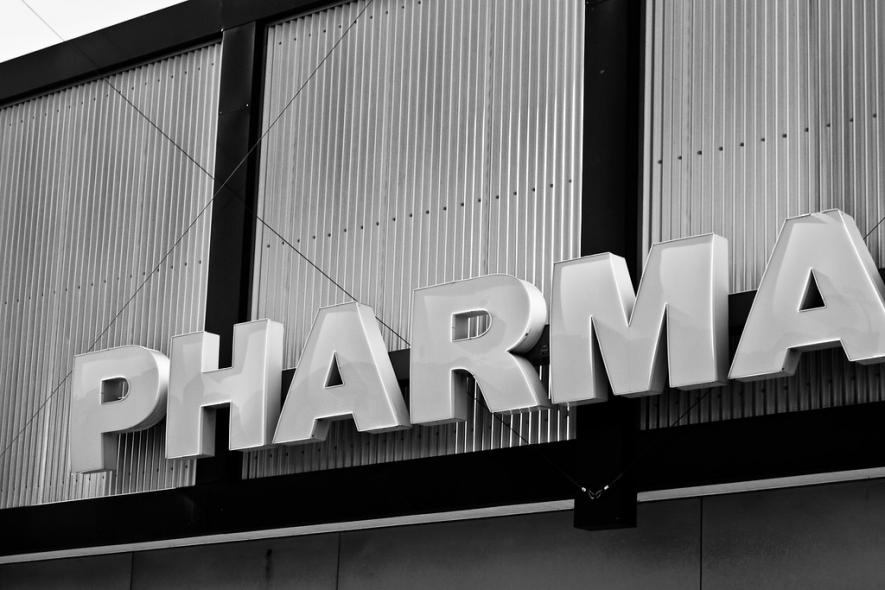Big Pharma– Maximum Earnings, Minimum Responsibilities

Representational image. | Image Courtesy: flickr
The contrast between the devastating effects of the Covid-19 pandemic on the lives and livelihood of the working-class population and the soaring profits of big pharma companies in the corresponding period is abhorrent.
Despite the huge jump in revenues during the global crisis and a forecast for the continuation of the good run—owing to an assured market for vaccines, drugs and diagnostics in the years to come—big pharma is reportedly lobbying against the proposed global deal on tax overhaul. Last month, about 130 countries agreed to the US call for a global minimum rate of corporate tax of 15 per cent.
Big pharma received substantial public funding and purchase commitments from various countries for research and development (R&D) of new vaccines due to which the market risks considerably tapered off. On top of this, pharma companies made enormous profits and are now refusing to pay more taxes.
WHOPPING PROFITS FOR BIG PHARMA
Most global pharma giants registered impressive growth in revenues during the first six months of 2021 against the corresponding period of 2020. The biggest gains were made by companies which developed vaccines and related diagnostics.
Bar chart no. 1 below shows the comparative revenues of major global pharma companies in the first six months of 2020 and 2021. Moderna, founded only about 11 years ago, registered a skyrocketing growth in revenues of 8,300%. Similar gains were made by Novavax (1,810%), Pfizer (68%), AstraZeneca (23%) and Johnson & Johnson (17%). All these companies achieved high revenues owing to vaccines and diagnostics.
PHARMA LOBBYING AGAINST GLOBAL TAX DEAL
Although the US government has secured the support of 130 countries, it is still uncertain whether the deal will see the light of day. The US Congress is yet to take up the issue and the Republicans are opposed to any increase in corporate tax. Under the deal, the proposed increase in corporate tax is just one of the measures within the wider overhaul of the rules for taxing international companies.
The Independent Commission for the Reform of International Corporate Taxation had suggested a global minimum corporate tax of 25 per cent. Civil society activists and economists have also been advocating for a higher corporate tax.
In a recent press release, the executive director of Oxfam International argued that a global minimum corporate tax rate of only 15 per cent is far too low and similar to the soft rates charged by tax havens like Ireland, Switzerland and Singapore. “It will do little to end the damaging race to the bottom on corporate tax and curtail the widespread use of tax havens,” Gabriela Bucher said.
According to an analysis by professor Aswath Damodaran of New York University for The Wall Street Journal: “Over the past decade, the world’s 20 largest pharmaceutical companies reported a global effective tax rate of about 17 per cent compared with about 21 per cent for the world’s 20 biggest tech companies—both lower than rates reported by very large companies in other sectors.” According to this analysis, Johnson & Johnson reported effective tax rates of 10.8 per cent in 2020 while Pfizer 5.8 per cent, the lowest among the biggest pharma companies.
In fact, pharma companies have been arguing that any increase in the tax rate might result in cuts in expenditure on research and development which, in turn, will adversely affect the availability of new medicines and vaccines. Citing the “exemplary” role of the pharma companies in combatting the pandemic, the pharma lobby has been pushing against any increase in the tax rates.
SUBSTANTIAL FUNDING TO BIG PHARMA
Although Big Pharma has been ‘playing the Covid card’, data shows that over the past two years, these companies were supported by several governments, multilateral institutions and philanthropy in their quest for developing new vaccines and medicines.
Bar chart no. 2 shows that most big pharma companies have received substantial public funding for the R&D of vaccines.
According to some estimates, the above figures may be an understatement. A November 2020 press release by Medicines Sans Frontieres had estimated that more than $12 billion was used for R&D, clinical trials and manufacture of six vaccines—AstraZeneca/Oxford University (over $1.7 billion), Johnson & Johnson/BiologicalE ($1.5 billion), Pfizer/BioNTech ($2.5 billion), GlaxoSmithKline/Sanofi Pasteur ($2.1 billion), Novavax/Serum Institute of India (nearly $2 billion) and Moderna/Lonza ($2.48 billion).
In addition to the direct funding for R&D, advanced purchase agreements (APAs) have been signed between countries and pharmaceutical companies to accelerate the development of vaccines. These APAs are signed before vaccine approval by a regulatory authority. As the agreements were made before the certainty in safety and efficacy of the vaccines, these are an additional incentive that reduces business risk in the R&D stage.
Activists have been demanding transparency on vaccine licensing deals, trial costs and data as deals with most pharma companies have not been made public.
Earlier, UK Prime Minister Boris Johnson had reportedly made a statement attributing the success of vaccines to capitalism or more precisely to “greed”. However, in contrast, a March 2021 report of the UK’s Industrial Strategy Council acknowledged the public funding support: “The government’s willingness to commit public money towards de-risking the Oxford/AstraZeneca vaccine development process for the University of Oxford and AstraZeneca was critical to success.”
Over the past two years, the pandemic has once again exposed the true nature of the capitalist system—profits being the primary driver with complete disregard to rising inequalities across the globe.
Get the latest reports & analysis with people's perspective on Protests, movements & deep analytical videos, discussions of the current affairs in your Telegram app. Subscribe to NewsClick's Telegram channel & get Real-Time updates on stories, as they get published on our website.
























